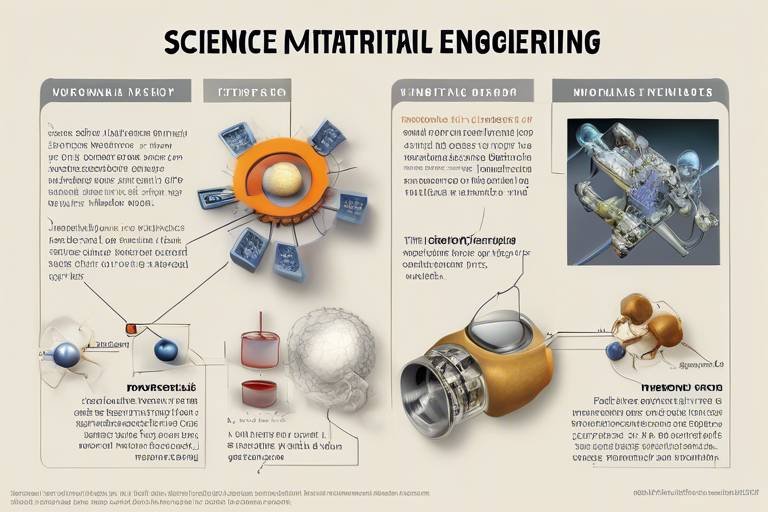Exploring the Science of Ethical AI Development
In a world increasingly driven by technology, the development of artificial intelligence (AI) is reshaping our lives in ways we could only dream of just a few decades ago. However, with great power comes great responsibility, and the ethical development of AI has become a hot topic of discussion among technologists, ethicists, and policymakers alike. So, what exactly does it mean to develop AI ethically? In essence, it involves creating AI systems that not only perform efficiently but also align with our moral values and societal norms. This commitment to ethical AI development is crucial for ensuring that these technologies serve humanity positively rather than causing harm or perpetuating existing biases.
Imagine AI as a powerful tool—like a double-edged sword. On one side, it has the potential to revolutionize industries, improve healthcare outcomes, and enhance our daily lives. On the other side, if not handled with care, it can lead to discrimination, privacy violations, and a host of other ethical dilemmas. This is where the principles of transparency, fairness, and accountability come into play. By embedding these principles into the AI development process, we can mitigate risks and foster trust among users. But how do we achieve this? Let’s dive deeper into the core aspects that guide ethical AI development.
Ethical AI refers to the design and implementation of AI systems that prioritize moral principles, ensuring that technology serves humanity positively while minimizing harm and bias in decision-making processes. This means that developers must consider not just the technical performance of AI systems but also their societal impact. The goal is to create AI that is beneficial for all, rather than a select few. For instance, consider how AI is used in hiring processes. If an AI system is trained on biased data, it may inadvertently favor certain demographics over others, leading to unfair hiring practices. Ethical AI seeks to address these issues head-on.
The development of ethical AI is guided by fundamental principles such as fairness, accountability, transparency, and privacy. Together, these principles create a framework for responsible AI practices that benefit society. Let’s break them down:
- Fairness: Ensuring that AI systems treat all individuals equitably, regardless of their background.
- Accountability: Holding developers and organizations responsible for the outcomes of their AI systems.
- Transparency: Providing clear information about how AI models operate and make decisions.
- Privacy: Safeguarding user data and ensuring it is used ethically.
By adhering to these principles, we can create AI systems that not only perform well but also contribute positively to society.
Fairness in AI focuses on eliminating biases in algorithms, ensuring equitable treatment across diverse demographics, and promoting inclusivity in AI-driven decisions. This is crucial for fostering trust and acceptance among users. But how do we ensure fairness? It begins with recognizing that biases can creep into AI systems through various channels, such as skewed training data or flawed algorithms. Therefore, it is essential to implement robust bias mitigation strategies.
Implementing bias mitigation strategies involves identifying and addressing sources of bias in training data and algorithms. This could mean diversifying the data used to train AI models, conducting regular audits to assess bias levels, and involving diverse teams in the development process. By enhancing the reliability and fairness of AI systems, we can ensure that they perform equitably in real-world applications.
Understanding the impact of AI on marginalized communities is crucial, as these groups often face disproportionate effects from biased AI systems. For instance, if an AI system used in law enforcement is trained on biased data, it may lead to over-policing in certain neighborhoods. Therefore, targeted efforts are necessary to ensure equitable outcomes and protect the rights of all individuals.
Accountability in AI development ensures that developers and organizations are responsible for the outcomes of their AI systems. This fosters trust and encourages ethical practices throughout the AI lifecycle. When organizations are held accountable, they are more likely to prioritize ethical considerations in their development processes, ultimately leading to better outcomes for society.
Transparency in AI systems involves clear communication about how AI models operate, the data they use, and their decision-making processes. This transparency enables users to understand and trust AI technologies. For example, when users know how an AI system arrived at a particular decision, they are more likely to accept its outcomes.
Explainable AI (XAI) aims to provide insights into AI decision-making processes, allowing users to comprehend the rationale behind outcomes. By making AI systems more interpretable, we can enhance user trust and reduce the fear of the unknown. Imagine trying to solve a puzzle without knowing what the picture looks like; that’s how users often feel when interacting with opaque AI systems.
Establishing regulatory frameworks for AI development is essential to ensure compliance with ethical standards, protect user rights, and promote responsible innovation in the rapidly evolving AI landscape. These frameworks can guide organizations in implementing ethical practices and provide a roadmap for accountability.
The future of ethical AI hinges on ongoing collaboration among technologists, ethicists, and policymakers to create robust guidelines that prioritize human values and address emerging challenges in AI deployment. As we look ahead, it’s clear that the journey towards ethical AI is not just a technical challenge but a societal imperative. By working together, we can shape a future where AI serves as a force for good, enhancing our lives while respecting our shared values.
Q: Why is ethical AI important?
A: Ethical AI is crucial because it ensures that AI technologies are developed responsibly, minimizing harm and bias while promoting fairness and accountability.
Q: What are some common biases found in AI?
A: Common biases in AI include racial, gender, and socioeconomic biases, which can arise from skewed training data or flawed algorithms.
Q: How can organizations ensure their AI systems are fair?
A: Organizations can ensure fairness by implementing bias mitigation strategies, conducting regular audits, and involving diverse teams in the development process.
Q: What role do regulatory frameworks play in ethical AI?
A: Regulatory frameworks provide guidelines for ethical practices, ensuring compliance with standards and protecting user rights in AI development.

Understanding Ethical AI
Ethical AI refers to the design and implementation of artificial intelligence systems that prioritize moral principles. In a world where technology is advancing at lightning speed, it’s crucial that we ensure these innovations serve humanity positively, rather than causing harm or exacerbating existing biases. Imagine AI as a powerful tool—like a double-edged sword. It can either cut through the complexities of data to deliver insightful solutions or, if wielded carelessly, it can lead to devastating consequences. This is where the concept of ethical AI comes into play.
At its core, ethical AI seeks to create systems that are not only efficient but also fair, transparent, and accountable. These principles serve as the foundation for responsible AI practices that can genuinely benefit society. For instance, consider how ethical AI can revolutionize sectors like healthcare, where it can help in diagnosing diseases more accurately. However, if the underlying systems are biased or lack transparency, the consequences could be detrimental, especially for vulnerable populations.
One of the critical aspects of understanding ethical AI is recognizing the importance of transparency. Users need to know how AI models operate and the data they utilize. This transparency builds trust and allows individuals to engage with technology more confidently. When users understand the decision-making processes of AI, they are more likely to accept its recommendations. For example, if an AI system is used to determine loan eligibility, it should be clear how it arrived at its conclusions. If users feel that the process is opaque, they may question the fairness of the decisions being made.
Moreover, ethical AI emphasizes the need for accountability. Developers and organizations must be responsible for the outcomes of their AI systems. This principle is crucial in fostering trust and encouraging ethical practices throughout the AI lifecycle. Think of it this way: if a self-driving car gets into an accident, who is held accountable? The manufacturer? The software developer? These questions highlight the necessity for clear accountability structures in AI development.
Lastly, it’s essential to recognize the role of privacy in ethical AI. As AI systems often rely on vast amounts of personal data, safeguarding user privacy is paramount. Users should have control over their data, understanding how it’s collected and used. This control not only protects individuals but also enhances the ethical standing of the AI systems in question.
In summary, understanding ethical AI is not just about adhering to a set of guidelines; it's about fostering a culture of responsibility, transparency, and fairness in the development and deployment of AI technologies. As we continue to innovate, keeping these principles at the forefront will ensure that AI remains a force for good in our society.
- What is ethical AI?
Ethical AI refers to AI systems designed with moral principles in mind, focusing on fairness, transparency, accountability, and user privacy. - Why is transparency important in AI?
Transparency helps users understand how AI systems make decisions, fostering trust and acceptance of technology. - How can we ensure fairness in AI?
By implementing bias mitigation strategies and ensuring diverse representation in training data, we can enhance the fairness of AI systems. - What role does accountability play in AI development?
Accountability ensures that developers and organizations take responsibility for the outcomes of their AI systems, which is crucial for ethical practices.

Key Principles of Ethical AI
When we talk about ethical AI, we’re diving into a pool of principles that act as the guiding light for developers and organizations alike. These principles are not just fancy words; they are the backbone of creating AI systems that are not only efficient but also fair, accountable, transparent, and respectful of privacy. Imagine building a house without a solid foundation—your structure might look good, but it won't stand the test of time. Similarly, these principles ensure that AI technologies benefit society rather than harm it.
At the heart of ethical AI lies the concept of fairness. This principle is all about ensuring that AI systems treat everyone equally, regardless of their background. Think about it: if an AI system is biased, it can lead to unfair treatment of certain groups, which can have real-world consequences. For instance, if an AI algorithm used in hiring processes favors one demographic over another, it not only perpetuates existing inequalities but also undermines trust in the technology itself. Fairness in AI isn’t just a checkbox; it’s a commitment to inclusivity and equity.
Accountability is another cornerstone of ethical AI. When AI systems make decisions, it’s crucial that there is someone—or some organization—responsible for those outcomes. This means developers and companies must be ready to answer for the actions of their AI systems. Imagine a self-driving car causing an accident; who’s at fault? This is where accountability becomes essential. It fosters trust among users and encourages developers to prioritize ethical practices throughout the AI lifecycle.
Next up is transparency. In a world where AI is becoming increasingly complex, users deserve to know how these systems work. Transparency means providing clear communication about the data used, the algorithms applied, and the reasoning behind decisions. It’s like showing your work in math class; it helps others understand the process and builds confidence in the results. When users can see how an AI system operates, they are more likely to trust its outcomes.
Lastly, we must consider privacy. With great power comes great responsibility, and AI technologies wield a lot of power over personal data. Developers must implement practices that protect user information and ensure compliance with privacy regulations. Creating AI that respects privacy isn’t just about avoiding legal issues; it’s about respecting individuals and their rights.
To summarize, the key principles of ethical AI serve as a framework for responsible development. They ensure that AI technologies are built on a foundation of fairness, accountability, transparency, and privacy, ultimately leading to systems that serve humanity positively. As we continue to innovate and integrate AI into various aspects of life, these principles will be our compass, guiding us toward a future where technology and ethics go hand in hand.
- What is ethical AI? Ethical AI refers to the design and implementation of AI systems that prioritize moral principles and aim to minimize harm.
- Why is fairness important in AI? Fairness ensures that AI systems treat all individuals equitably, preventing biases that can lead to discrimination.
- How can accountability be enforced in AI development? Accountability can be enforced by establishing clear responsibilities for developers and organizations regarding the outcomes of their AI systems.
- What role does transparency play in AI systems? Transparency allows users to understand how AI systems operate, fostering trust and confidence in their decisions.
- Why is privacy a critical consideration in AI? Privacy is crucial because AI systems often handle sensitive personal data, and protecting that data is essential to uphold user rights.

Fairness in AI
is not just a buzzword; it’s a critical element that shapes the future of technology and its impact on society. Imagine a world where decisions made by algorithms can influence your job prospects, loan approvals, or even healthcare options. If these systems are biased, they can perpetuate inequality and discrimination. Therefore, ensuring fairness in AI is essential for fostering trust and acceptance among users.
At its core, fairness in AI means eliminating biases that can arise from the data used to train algorithms. These biases can stem from various sources, including historical data that reflects societal inequalities or even the way algorithms are designed. To tackle these issues, developers must adopt a proactive approach, focusing on inclusivity and equitable treatment across diverse demographics.
Here are some key strategies for promoting fairness in AI:
- Data Diversification: Using diverse datasets that represent various groups can help mitigate bias.
- Algorithmic Auditing: Regularly reviewing algorithms for bias and fairness can ensure that they perform equitably.
- User Feedback: Incorporating feedback from affected communities can guide improvements in AI systems.
The impact of unfair AI systems can be particularly pronounced on marginalized communities. These groups often bear the brunt of biased algorithms, leading to adverse outcomes in critical areas such as employment, justice, and healthcare. For instance, if an AI system used for hiring is trained predominantly on data from one demographic, it may unfairly disadvantage applicants from other backgrounds. This is why understanding the impact of AI on these communities is not just important; it’s essential.
In summary, fairness in AI is about creating systems that recognize and respect the diversity of human experience. It’s about ensuring that technology serves everyone, not just a select few. By actively working to eliminate biases and promote inclusivity, we can build AI systems that not only function effectively but also enhance social equity.

Bias Mitigation Strategies
When it comes to developing ethical AI, one of the most pressing challenges is addressing bias. Bias can seep into AI systems through various channels, often leading to unfair treatment of certain groups. Therefore, implementing is crucial for enhancing the reliability and fairness of AI systems in real-world applications. But what does this actually involve? Well, it’s a multi-faceted approach that requires a thorough understanding of both the data and the algorithms being used.
First and foremost, identifying the sources of bias in training data is essential. This involves scrutinizing datasets to detect any patterns or discrepancies that may lead to skewed outcomes. For instance, if a facial recognition system is trained predominantly on images of one demographic, it may struggle to accurately recognize individuals from other backgrounds. To combat this, developers should strive for diverse datasets that reflect the broad spectrum of humanity. This not only helps in creating more accurate models but also fosters inclusivity.
Another effective strategy is to employ algorithmic adjustments that can minimize bias during the training process. This might include techniques such as re-weighting or re-sampling the data to ensure that underrepresented groups are adequately represented. By tweaking the algorithms, developers can help the AI learn to treat all individuals equitably, regardless of their demographic background.
Moreover, continuous monitoring and evaluation of AI systems post-deployment are vital. It’s not enough to just build an unbiased system; one must also ensure that it operates fairly in the real world. This can involve gathering feedback from users, analyzing outcomes, and making necessary adjustments to the algorithms. In fact, creating a feedback loop where users can report issues can significantly enhance the system's fairness over time.
To summarize, effective bias mitigation strategies encompass:
- Identifying sources of bias in training data
- Employing diverse datasets
- Implementing algorithmic adjustments
- Continuous monitoring and evaluation post-deployment
Ultimately, the goal is to create AI systems that not only function effectively but also uphold the principles of fairness and inclusivity. By taking these steps, developers can contribute to a future where AI technologies serve all members of society equitably, fostering trust and acceptance among users.
- What is bias in AI? Bias in AI refers to systematic errors that result in unfair treatment of individuals based on characteristics such as race, gender, or socioeconomic status.
- How can bias be identified in AI systems? Bias can be identified through data analysis, testing algorithms on diverse datasets, and monitoring outcomes for fairness.
- Why is bias mitigation important? Mitigating bias is crucial to ensure that AI systems promote fairness, accountability, and trust among users.
- What are some examples of bias mitigation strategies? Examples include using diverse training datasets, algorithmic adjustments, and continuous monitoring of AI systems.

Impact on Marginalized Communities
The impact of artificial intelligence (AI) on marginalized communities is a pressing concern that cannot be ignored. As AI systems increasingly influence decisions in areas such as hiring, law enforcement, and healthcare, the potential for bias to disproportionately affect underrepresented groups becomes alarmingly apparent. Imagine walking into a job interview, feeling confident about your qualifications, only to discover that an algorithm has already decided your fate based on a dataset that fails to represent your demographic accurately. This is not just a hypothetical scenario; it happens more often than we think.
Marginalized communities—whether defined by race, gender, socioeconomic status, or other factors—often bear the brunt of flawed AI systems. For instance, consider the criminal justice system, where predictive policing algorithms may rely on historical data that reflects systemic biases. These biases can lead to over-policing in certain neighborhoods while neglecting others, creating a vicious cycle of mistrust and inequality. The consequences are far-reaching, as they can affect everything from individual lives to broader societal dynamics.
To understand the gravity of this issue, let’s delve into some key points:
- Data Representation: Many AI systems are trained on datasets that do not adequately represent the diversity of the population. This lack of representation can lead to decisions that are not only unfair but also harmful.
- Discrimination: Algorithms can inadvertently perpetuate existing stereotypes and biases, leading to discriminatory practices that further marginalize vulnerable groups.
- Lack of Accountability: Often, those developing AI systems do not fully consider the implications of their work on marginalized communities, leading to a lack of accountability for negative outcomes.
In light of these challenges, it is crucial for developers and organizations to actively engage with marginalized communities during the AI development process. This engagement can help ensure that the voices of those most affected are heard and that their needs are addressed. For example, involving community representatives in the design and testing phases of AI systems can lead to more equitable outcomes. Moreover, establishing feedback loops where affected communities can report issues with AI systems will foster a culture of accountability and improvement.
Ultimately, addressing the impact of AI on marginalized communities is not just a matter of fairness; it is essential for building trust in technology. If AI systems are to be seen as beneficial tools rather than threats, they must be developed with a keen awareness of their societal implications. By prioritizing inclusivity and fairness in AI development, we can create a future where technology serves all of humanity, not just a privileged few.
Q1: What are the main risks associated with AI for marginalized communities?
A1: The main risks include biased decision-making, lack of representation in datasets, and the potential for discrimination in areas like hiring and law enforcement.
Q2: How can we mitigate the impact of AI on marginalized groups?
A2: Engaging with affected communities during the development process, ensuring diverse representation in training datasets, and implementing bias mitigation strategies are crucial steps.
Q3: Why is transparency important in AI systems?
A3: Transparency helps users understand how AI systems make decisions, which builds trust and allows for accountability when biases or errors occur.
Q4: What role do policymakers play in ethical AI development?
A4: Policymakers are essential in creating regulations that ensure AI systems adhere to ethical standards and protect the rights of marginalized communities.

Accountability in AI Development
Accountability in AI development is not just a buzzword; it’s a crucial aspect that ensures the integrity and reliability of AI technologies. As we plunge deeper into the age of artificial intelligence, the stakes are higher than ever. Developers and organizations must recognize that they are not only creators of technology but also stewards of the ethical implications that come with it. When an AI system makes a decision, it can significantly impact lives, and that’s where accountability becomes paramount.
Imagine a world where AI systems operate without oversight. It’s a bit like letting a child play with fire without any guidance. The potential for harm is immense, and that’s why accountability is essential. Developers need to take responsibility for their creations, ensuring that they function as intended and do not perpetuate harm. This involves a commitment to ethical practices throughout the entire AI lifecycle, from conception to deployment.
To foster accountability, organizations can implement several key strategies:
- Clear Documentation: Maintaining thorough documentation of the AI development process helps track decisions and methodologies used, making it easier to identify areas of concern.
- Regular Audits: Conducting regular audits of AI systems can help identify biases or errors that may arise during operation, ensuring that the system remains compliant with ethical standards.
- User Feedback Mechanisms: Establishing channels for user feedback allows organizations to gather insights on the AI system's performance and impact, leading to continuous improvement.
Furthermore, organizations must be prepared to face the consequences of their AI systems' actions. This means having procedures in place for addressing grievances and rectifying any harm caused by AI decisions. A transparent approach not only builds trust with users but also encourages ethical practices across the industry.
One of the significant challenges in ensuring accountability is the complexity of AI systems. With algorithms that can learn and evolve, it can be difficult to pinpoint where things went wrong when a mistake occurs. This is where interdisciplinary collaboration becomes vital. By bringing together technologists, ethicists, and legal experts, organizations can develop a more comprehensive understanding of accountability in AI development.
In conclusion, accountability in AI development is not just about assigning blame when things go wrong; it’s about fostering a culture of responsibility and transparency. As we continue to innovate and integrate AI into various aspects of life, we must ensure that accountability remains at the forefront of our efforts. Only then can we build AI systems that are not only advanced but also ethical and trustworthy.
- What is accountability in AI development? Accountability in AI development refers to the responsibility that developers and organizations have for the outcomes of their AI systems, ensuring ethical practices throughout the AI lifecycle.
- Why is accountability important in AI? Accountability is crucial because AI systems can significantly impact lives, and ensuring responsible use helps to prevent harm and build trust among users.
- How can organizations ensure accountability? Organizations can ensure accountability through clear documentation, regular audits, and user feedback mechanisms, among other strategies.
- What challenges exist in ensuring accountability for AI systems? The complexity of AI systems can make it difficult to identify where errors occur, necessitating collaboration among various disciplines to address accountability effectively.

Transparency in AI Systems
In the rapidly evolving landscape of artificial intelligence, transparency plays a pivotal role in building trust between technology and its users. Imagine walking into a room filled with mysterious machines, each humming and whirring, but you have no idea what they are doing or how they make decisions. That’s how many people feel about AI today. Transparency in AI systems involves clear communication about how these models operate, the data they utilize, and the decision-making processes they follow. By shedding light on these aspects, we can demystify AI and foster a sense of trust among users.
One of the key aspects of transparency is the ability to understand the algorithms at play. When users can see how decisions are made, they’re more likely to trust the outcomes. For instance, if an AI system is used to determine loan eligibility, it’s crucial for applicants to know what factors are being considered. Are their credit scores the only thing that matters? What about their income or job stability? By providing insights into these considerations, organizations can promote a sense of fairness and accountability.
Moreover, transparency is not just about the algorithms; it also encompasses the data used to train these models. Data is the lifeblood of AI, and understanding its sources is essential. Are the data sets diverse and representative? Are they free from biases that could skew results? Addressing these questions helps ensure that AI systems serve all segments of society fairly. To illustrate this, consider the following table that highlights the importance of data diversity:
| Data Diversity Aspect | Impact on AI Systems |
|---|---|
| Demographic Representation | Ensures that AI decisions are fair and unbiased across different groups. |
| Data Quality | High-quality data leads to more accurate AI predictions and decisions. |
| Data Quantity | More data can improve model performance, but it must be relevant and diverse. |
Furthermore, the concept of Explainable AI (XAI) is closely tied to transparency. XAI aims to provide insights into AI decision-making processes, allowing users to comprehend the rationale behind outcomes. For example, if an AI denies a loan application, it should be able to explain why, in terms that the applicant can understand. This not only builds trust but also empowers users to challenge or appeal decisions if they feel they’ve been treated unfairly.
Finally, establishing regulatory frameworks for AI development is essential to ensure compliance with ethical standards. These frameworks can mandate transparency, requiring organizations to disclose how their AI systems operate and the data they use. This creates an environment where responsible innovation can flourish while protecting user rights. In a world where AI is increasingly influencing our lives, transparency is not just a nice-to-have; it’s a fundamental requirement.
- What is transparency in AI? Transparency in AI refers to the clear communication about how AI models operate, the data they utilize, and their decision-making processes.
- Why is transparency important? Transparency builds trust between users and AI systems, allowing users to understand and accept AI-driven decisions.
- What is Explainable AI? Explainable AI (XAI) aims to provide insights into AI decision-making processes, making AI systems more interpretable and trustworthy.
- How can regulatory frameworks improve transparency? Regulatory frameworks can mandate organizations to disclose how their AI systems work and the data they use, fostering responsible innovation.

Explainable AI
Imagine you're driving a car, and suddenly the brakes engage without you pressing the pedal. You'd want to know why, right? This is where Explainable AI (XAI) comes into play. It's all about making the decision-making processes of artificial intelligence systems transparent and understandable. In a world where AI is becoming increasingly integral to our daily lives, the need for clarity is more important than ever. Users must comprehend not only the outcomes of AI decisions but also the reasoning behind them. This understanding fosters trust and confidence in AI technologies.
At its core, XAI seeks to demystify the 'black box' nature of many AI systems. Traditional AI models, particularly those based on deep learning, often operate in ways that can seem opaque. Users might receive results without any context or explanation, leading to skepticism or fear. For instance, if an AI system denies a loan application, the applicant deserves to know the rationale behind that decision. Was it based on their credit score, income, or some other factor? By providing clear explanations, AI can enhance user satisfaction and acceptance.
To illustrate the importance of explainable AI, consider the following table that outlines the benefits of XAI:
| Benefit | Description |
|---|---|
| Trust | Users are more likely to trust AI systems that provide clear explanations for their decisions. |
| Accountability | When AI systems are explainable, developers and organizations can be held accountable for their outcomes. |
| Bias Detection | Understanding AI decision-making helps identify and mitigate biases in algorithms. |
| Improved Performance | Insights from explainable AI can lead to better model tuning and performance enhancements. |
Incorporating explainable AI into the development process is not just a technical challenge; it also raises ethical questions. Developers must strike a balance between complex algorithms and user-friendly explanations. This can be achieved through various methods, such as using simpler models when appropriate or employing techniques that provide insights into more complex models. For example, feature importance techniques can help identify which variables significantly influence an AI's decision, making it easier for users to grasp the underlying logic.
Moreover, the push for explainable AI is gaining traction globally, with many organizations advocating for its adoption. Regulatory bodies are beginning to recognize the necessity of transparency in AI systems. As a result, companies are increasingly investing in XAI technologies to ensure compliance and build consumer trust.
In conclusion, is not just a trend; it's a crucial component of responsible AI development. By prioritizing clarity and transparency, we can create AI systems that not only perform effectively but also earn the trust of users. As we move forward, the challenge will be to integrate explainability into the fabric of AI systems, ensuring that technology serves humanity in a fair and comprehensible manner.
- What is Explainable AI? Explainable AI refers to methods and techniques that make the outputs of AI systems understandable to humans.
- Why is Explainable AI important? It builds trust, ensures accountability, and helps detect biases in AI systems.
- How can we achieve Explainable AI? By using simpler models when possible, employing techniques to interpret complex models, and ensuring clear communication of AI processes.

Regulatory Frameworks
As the landscape of artificial intelligence evolves at an unprecedented pace, the establishment of becomes not just important, but essential. These frameworks serve as the backbone for ethical AI development, providing guidelines that ensure compliance with ethical standards while protecting user rights. Imagine navigating a bustling city without traffic lights; chaos would ensue. Similarly, without clear regulations, the AI ecosystem risks spiraling into a realm of unchecked innovations that could lead to unintended consequences.
Regulatory frameworks are designed to address a multitude of concerns, including privacy protection, data security, and the accountability of AI systems. Governments and organizations around the world are beginning to recognize the necessity of these frameworks. For instance, the European Union has proposed the AI Act, which aims to categorize AI systems based on risk levels and impose stricter regulations on high-risk applications. This initiative exemplifies how regulatory bodies are stepping up to ensure that the deployment of AI technologies is both responsible and beneficial to society.
Moreover, these frameworks are not static; they evolve alongside technological advancements. Continuous dialogue among stakeholders—such as technologists, ethicists, and policymakers—is crucial for adapting regulations to new challenges that arise in the AI arena. This collaboration can be visualized as a symphony, where each instrument must harmonize to create a melody that resonates with the values of society. In this case, the melody is one of trust, safety, and ethical integrity.
To illustrate the various aspects of regulatory frameworks, consider the following table, which outlines key components typically included in these guidelines:
| Component | Description |
|---|---|
| Data Privacy | Ensures that user data is collected, stored, and processed in compliance with privacy laws. |
| Accountability | Defines who is responsible for the outcomes of AI systems and how they can be held accountable. |
| Transparency | Requires clear communication regarding how AI systems make decisions and the data they utilize. |
| Bias Mitigation | Establishes protocols for identifying and reducing biases in AI algorithms to promote fairness. |
In addition to these components, regulatory frameworks also aim to foster innovation while ensuring that ethical considerations remain at the forefront. This balancing act is akin to walking a tightrope; one misstep could lead to either stifling creativity or allowing harmful practices to flourish. Thus, it's imperative that regulations are not overly restrictive, yet robust enough to safeguard against potential risks.
Ultimately, the goal of regulatory frameworks in AI development is to create an environment where technology can thrive without compromising human values. As we look to the future, it is clear that the collaboration among various stakeholders will play a pivotal role in shaping a landscape where ethical AI is not just a possibility but a reality.
- What is the purpose of regulatory frameworks in AI?
Regulatory frameworks aim to ensure that AI technologies are developed and implemented responsibly, protecting user rights and promoting ethical practices. - How do these frameworks evolve?
They evolve through ongoing discussions among technologists, ethicists, and policymakers, adapting to new challenges and technological advancements. - Can regulatory frameworks stifle innovation?
While they aim to protect users, overly restrictive regulations can hinder creativity. The key is to find a balance that encourages innovation while ensuring safety.

Future of Ethical AI
The future of ethical AI is an exciting frontier that promises to redefine how we interact with technology. As we stand on the brink of an AI revolution, it is essential to recognize that the path we choose will shape not only our technological landscape but also the moral fabric of our society. The collaboration between technologists, ethicists, and policymakers will be crucial in creating robust guidelines that prioritize human values. Imagine a world where AI systems enhance our lives without compromising our ethics—a world that is not just smart, but also fair and just.
One of the key elements in ensuring the future of ethical AI is the integration of diverse perspectives. By bringing together voices from various backgrounds, we can better understand the implications of AI technologies on different communities. This collaboration will help identify potential biases and address them before they become entrenched in AI systems. For instance, when developing AI for healthcare, involving medical professionals, patients, and ethicists can lead to more equitable outcomes. This collective approach will not only enhance trust but also foster innovation that reflects the needs of all users.
Moreover, as AI technologies continue to evolve, so too must our understanding of ethical considerations. Emerging challenges, such as the use of AI in surveillance or decision-making in criminal justice, require ongoing dialogue and adaptation of ethical frameworks. We must ask ourselves: what principles should guide the use of AI in these sensitive areas? How can we ensure that the benefits of AI are distributed fairly across society? Addressing these questions will be vital in shaping a future where AI serves as a tool for empowerment rather than oppression.
To facilitate this ongoing conversation, educational initiatives will play a significant role. By incorporating ethics into the curriculum for AI and data science programs, we can equip the next generation of developers with the tools they need to create responsible AI systems. This education should not be limited to technical skills; it must also encompass an understanding of the societal impacts of AI. As we prepare future leaders in technology, we must emphasize the importance of ethical decision-making alongside technical proficiency.
In addition to education, the establishment of regulatory frameworks will be essential. These frameworks should not only set standards for ethical AI development but also provide mechanisms for accountability. As AI systems become more integrated into our daily lives, it is crucial that users feel confident in the technologies they interact with. This confidence can only be achieved through transparency and clear communication about how AI models operate and the data they utilize. For example, organizations should be required to disclose the algorithms behind their AI systems, allowing users to understand how decisions are made.
Finally, the future of ethical AI will depend on our ability to adapt to new challenges and opportunities. As AI technology advances at a rapid pace, we must remain vigilant and proactive in addressing ethical dilemmas. Continuous research and dialogue among stakeholders will be necessary to refine our understanding of what ethical AI means in practice. By fostering a culture of responsibility and ethical awareness, we can ensure that AI continues to evolve in a way that benefits all of humanity.
- What is ethical AI? Ethical AI refers to the design and implementation of AI systems that prioritize moral principles, ensuring technology serves humanity positively while minimizing harm and bias.
- Why is transparency important in AI? Transparency in AI systems allows users to understand how decisions are made, fostering trust and ensuring accountability in AI technologies.
- How can we mitigate bias in AI? Bias mitigation strategies involve identifying and addressing sources of bias in training data and algorithms, ensuring equitable treatment across diverse demographics.
- What role do policymakers play in ethical AI? Policymakers are essential in establishing regulatory frameworks that ensure compliance with ethical standards and protect user rights in AI development.
Frequently Asked Questions
- What is ethical AI?
Ethical AI refers to the development and implementation of artificial intelligence systems that prioritize moral principles. It aims to ensure that technology serves humanity positively while minimizing harm, bias, and unfairness in decision-making processes.
- Why is fairness important in AI?
Fairness is crucial in AI because it helps eliminate biases in algorithms, ensuring equitable treatment across various demographics. This inclusivity fosters trust and acceptance among users, making AI systems more reliable and socially responsible.
- How can bias be mitigated in AI systems?
Bias mitigation strategies involve identifying and addressing sources of bias in training data and algorithms. Techniques such as diverse data sampling, algorithm adjustments, and continuous monitoring can enhance the fairness and reliability of AI systems.
- What impact does AI have on marginalized communities?
AI can disproportionately affect marginalized communities, often leading to unfair outcomes. Understanding these impacts is essential for developing targeted efforts to ensure equitable results and reduce harm to these vulnerable groups.
- What does accountability mean in AI development?
Accountability in AI development means that developers and organizations are responsible for the outcomes of their AI systems. This principle fosters trust and encourages ethical practices throughout the AI lifecycle, ensuring that users are protected.
- How does transparency benefit AI users?
Transparency in AI systems allows users to understand how AI models operate, the data they utilize, and their decision-making processes. This clear communication builds trust and enables users to feel more comfortable interacting with AI technologies.
- What is Explainable AI (XAI)?
Explainable AI (XAI) refers to methods and techniques that make AI decision-making processes more interpretable. By providing insights into how AI arrives at certain outcomes, XAI enhances user comprehension and trust in AI systems.
- Why are regulatory frameworks necessary for AI?
Regulatory frameworks are essential for ensuring compliance with ethical standards, protecting user rights, and promoting responsible innovation in the rapidly evolving AI landscape. They help create guidelines that prioritize human values and address emerging challenges.
- What does the future hold for ethical AI?
The future of ethical AI relies on collaboration among technologists, ethicists, and policymakers. By working together, these groups can create robust guidelines that prioritize human values and address the challenges posed by AI deployment in society.



















